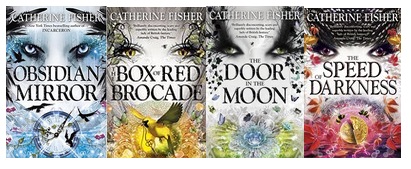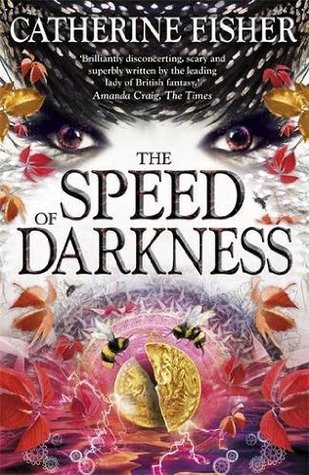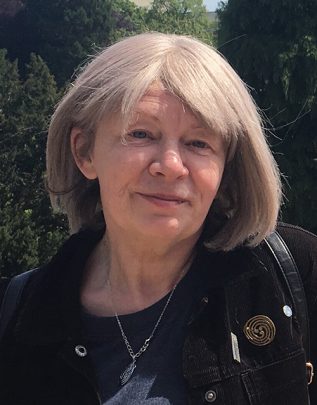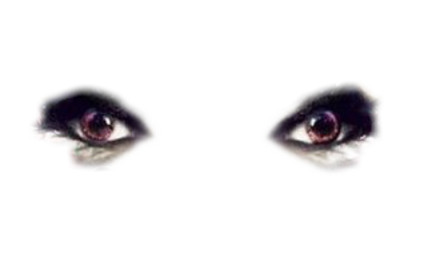Catherine Fisher has conquered the three peaks of literature; her Young Adult novels and her poetry are critically lauded, award-winning, and best-selling. Here, ahead of the publication of the fourth in her acclaimed Chronoptika Quartet, The Speed of Darkness, Catherine explains the challenges and rewards of attempting such an ambitious project.
The request from the blogger’s website was quite clear.
Please sum up your work in five words.
It was one of a list of questions — the others mostly about my favourite film/ music/ TV — irritating enough to answer. But this one made me sit back in my chair.
Did I even want to reduce five years work to a single phrase? What would be the point? What could it possibly say about the story, the characters, the slow development of the plot, the days and hours of dreaming and walking and lying awake in bed plotting, of notes scribbled on train journeys, of passages dashed down in buses or coffee shops? Even hospital waiting rooms?
What could it say about the way the book moved seamlessly in and out of ordinary life, edged like a ghost between other pages, obtruded into conversations where I was talking about something else, nudged at moments when a word or an image skags on the imagination like wool on a spiky hedge?
Nothing.
The temptation was write something flippant, or worse.
But of course, I didn’t.
The Chronoptika Quartet project began back in about 2011 when I pitched the idea to my publisher. Weary from long difficult angsty books, I suggested a lighter set of seven stories, featuring younger characters who discover a time travel device and use it for adventures. Reader ages, about 9-12. I envisaged light-hearted, short easy books that would be quick to write, a sort of Five Go Through the Magic Mirror.

My publisher thought about it and came back with objections. First, my readers were Young Adults, so why abandon an established fan base? They would expect the next Catherine Fisher to be for them, not younger children, and would be disappointed and wouldn’t buy it. Also seven books was too many. How about three?
I wasn’t too dismayed, as by then the idea had begun its inevitable growth into more complicated spirals of story. I knew secretly that the idea of shorter, thinner books was uninspiring and would probably bore me; any actual adventures in time would not be as interesting as the paradoxes and vexed questions they would inevitably raise: should we change the past? What might be the consequences? Would we want to know the future, and if we did, how would it affect our actions in the present? Any story exploring these notions would need readers of a certain sophistication.
So the plan changed. I decided to write four novels, one for each season of the year, starting in the depths of Winter. There would be a whole set of interesting characters. There would be one overriding story arc, and in each book, an adventure that would be resolved, but move the main plot on.
The time travel device was a Mirror. I decided on that quite early, but then it became an Obsidian Mirror, and only after inventing it — and a character called Mortimer Dee — did I remember the real Dr Dee and his dark scrying device. Unconscious borrowings happen all the time.
The Mirror is obtained by Oberon Venn, the hero — or antihero — of the set. Venn’s wife Leah has been killed in an accident for which he is responsible. Devastated, he becomes a recluse in the gothic family pile of Wintercombe Abbey, until his friend David suggests trying to activate the Mirror to change the past. Things go wrong; David’s son, Jake, the protagonist, far away in a Swiss school realizes his father is missing and believes Venn is responsible. So he breaks out and comes home to find out what’s happening.

Meanwhile a girl appears through a slot in the air in a field near the Abbey. She is breathless, terrified, and pursued by a Wolf made of Ice. Sarah is escaping from the far future that the use of the Mirror has created.
It’s hard to think back now to the beginning of the project but usually ideas, images and themes arrive while the writing is in progress, in a fairly spontaneous process. There is not much planning, which makes the process more difficult but at least gives nothing away.
Other characters quickly appeared — Jake’s stolid teacher, Mr Wharton, Venn’s servant Piers, the changeling Gideon, the mysterious scarred man Maskelyne and his friend Rebecca. But a second element was also urgently intruding. Folklore.
Time travel is SF but fairies are folklore. What about mixing the two?
In the great Wood that surrounds Wintercombe Abbey live the Shee. Their queen, Summer, is a version of the traditional fairy queen, but her sights are set on Venn and she does not want him to get his wife back. Dangerous, amoral, selfish, the Shee are almost a manifestation of the birdlife and changing seasons of the Wood, the unpredictable elements of Nature.
Mixing fairylore with the SF concept of timetravel is a risky business, and maybe not always successful. Certainly at first I felt a certain sense of them tugging apart, of seams difficult to hold together. As the quartet progresses the elements coalesce and knit; I hope by the end they have fully fused.
I’m not sure if publishers like such eclecticism. Booksellers too prefer to put books in definite categories — but then fantasy is an all-embracing sort of word, and Young Adult completes the pigeonholing. Neither is particularly descriptive, which is just as well.

My final ingredient in the cauldron was Shakespeare. I decided to use inside each book what I call a ‘coathanger’ — a secret framework to hang the book on. Each of the four volumes would have a Shakespeare play lurking at its heart — not that I would follow the plot, but would borrow quotes, motifs, themes. It would make the book more interesting for me and hopefully the reader.
So the books would be complex and have a lot going on. For some readers, maybe too much. Certainly they became the opposite of the initial stripped-down, linear proposal. But the writer needs to enjoy and feel challenged by the process of creating, and this rich brew was what I wanted to work with.
The first book, The Obsidian Mirror appeared in August 2012 and had excellent reviews. I was encouraged and began book two, The Box of Red Brocade, which as usual took about a year to appear.
There are obvious benefits from writing a series, both for writer and reader. The characters and setting are established, a relationship with them already formed. For the reader looking for a book in which to lose themselves, there is a comforting sense of security — of revisiting a familiar and well-liked story. Readers who enjoyed book 1 are likely to go onto book 2. Above all for the author there is a sense of continuity and security, unusual indeed in the freelance writer’s life.
But maybe that’s an illusion, because the problems with a series are immense. First, if the reader doesn’t like book 1, they won’t buy book 2, or any of your next few years’ work. You have, in fact, lost them, maybe for ever. Also the law of diminishing returns means that sales of books 2, 3 and 4 are never going to exceed those of book 1, and are sure to decrease as the series goes on, as many readers, for whatever reason, won’t make it to the end.
Another problem is with critical response. This is vanishingly small in any case for Young Adult fiction, with print newspaper and journals no longer reviewing except in end-of-year summaries. The considered reviews of a few decades ago just don’t exist. And with a series, even if book 1 gets some notices, the others will not. Nor — however good they may be — are they likely to be considered for prizes. (There is an obvious exception here with Phillip Pullman’s Whitbread win for the third volume of his trilogy, but that is exceptional.)
The only hope of critical response is now on-line, and certainly fans and bloggers can be gratifyingly enthusiastic and loyal. So by book 3, The Door in the Moon, I was fairly clear how the responses to the series were going, and free to concentrate on the intricacies of plot, because I certainly find developing the series of events in a story the hardest part.
Book 4, The Speed of Darkness, appears this month, [February 2016], and of course presents its own problems — how to tie up the story, leaving no loose ends, and yet maybe a tiny thread to tease the attentive reader. For that reason, it’s certainly the most difficult of the set.
My summary of the Chronoptika for the blog in five words was, as you’ve guessed, the title of this piece.
But its not even half the story.
To find out more about Catherine Fisher and the Chronoptika Quartet series visit her website.
_______________________________________________________________________
Recommended for you:
Catherine Fisher | Writers’ Rooms
In the latest of our Writers’ Rooms series we take a peek at the work space of poet and best-selling children’s author Catherine Fisher. The Oracle (2003) was shortlisted for the Whitbread Children’s Book Prize, and Incarceron (2010) was The Times Children’s Book of the Year and a New York Times Bestseller. Writer of over 30 books, including the Chronoptika Quartet series, Fisher can certainly lay claim to being one of Wales’ most successful and widely loved writers.
______________________________________________________________________












